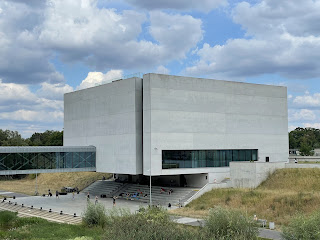Day 11: Poznań
- Distance: 10.7km 🙂
- Average Speed: 6km/h 🙂
- Legs: 🙂
- Undercarriage: 🙂
- Hands: ☹️ - still tingly and weird
- Bike: 🙂
As is always the case on a rest day, I woke up refreshed and feeling like I could jump on the bike and do another 180k. After a hurried conference between my legs, my bum and my hands, that idea was firmly binned and I had a relaxing day of seeing the sights in Poznań to look forward to.
There was a bit of “Jack Reacher” shopping to do. A new T-shirt, some toothpaste and a three pack of sports socks all told cost me €25 and I could bin the old ones later on in the day. The “Old Brewery” shopping centre was outstandingly beautiful — and it’s not often you can say that about a shopping centre.
A retail cathedral.
The “w” is pronounced “v”.
Update: my friend Andy Sobek — who has Polish ancestry as his surname indicates — tells me that “rowery” is the plural. So a “bike” is a “rower” which is even better.
I had three things I wanted to do but first I had to see the fighting goats. Starting in 1551, at noon, two clockwork goats appear high up on clock above the main market square in Poznań and butt their heads 12 times.
Goats butting on the left, lone trumpeter just visible on the right.
Go goats go!
It’s a bold thing to do and in the small areas where it’s nearly complete, you can see how beautifully the streets are being relaid with the original cobbles and pedestrians are being given priority over the car — but not the tram naturally. Partially hidden behind the barriers and the dust, Poznań is a vibrant city with some fantastic streets and monuments. One has to keep reminding oneself that a lot of the traditional “old” buildings are either new or extensively renovated and rebuild. Poland spent most of the 20th century having either Russian or German armies rolling over it either attacking or retreating. Multiple pitched battles inside major cities does not result in a lot of architectural history surviving undamaged.
The main place I wanted to go to in Poznań was the Enigma Museum. Just down from Zamek Cesarski palace, there’s a (rebuilt) building which contains an academic research facility and a multi-media exhibition about the history of code breaking in Poland and the cracking of the Enigma code.
This is going to be good.
The one take-away which they are very keen for visitors to understand is that the Enigma code was broken by Polish mathematicians. In the UK we often refer to Alan Turing as the person who broke the Enigma code. This is not true. It was broken from 1932-1939 by three Polish mathematicians who subsequently and covertly gave their work to the French in 1939 and the French then passed the work on to the newly formed Bletchley Park operation. Alan Turing was brilliant and a critical part of the effort (especially in designing and building the “bombes” which sped up deciphering a great deal) but he didn’t break the Enigma code.
It has been estimated that the intelligence produced by the broken Enigma code (so-called Ultra) shortened the war by 2 years and may have saved 10 million lives. Thanks mathematics!
Over on the other side of town was another museum called Porta Posnania which is about the history of Poznań and the cathedral which (unsurprisingly) has been rebuilt a number of times. The building itself is a rather fetching brutalist concrete block on the banks of the river.
Well, I liked it.
And I thought the Derwent Pencil Museum was weird.
Rest days are about having a snooze and so I had a snooze and then ate on the delightful rooftop restaurant in my hotel.
Cycling through a country gives you an opportunity to see more than you would normally get flying into the capital city for a weekend break or a business meeting. Whilst one has to be careful extrapolating from a few days, there is, to me at least, a real feeling of “progress” in Poland. The little shotgun-consonant villages are full of new build pleasant airy houses, Poznań is full of groovy restaurants, bars and tech startup hubs. Everybody I meet smiles indulgently when I use my stock phrase “I am so terribly sorry, I speak no Polish” and replies “but I speak some English so we are good” and we smile together.
The economic gradient from the Netherlands through the old West Germany, into the old East Germany and then into Poland has been noticeable. Everything gets a little bit more tired but only in Poland have I felt that the direction of travel is upwards and onwards. Sitting here on the beautiful roof-top restaurant in my hotel surrounded by the upwardly mobile young Poles splashing out on a fancy evening…I love it.
Back on the bike tomorrow. Headwind forecast but only 130km to a tiny one hotel town in the middle of nowhere. Hope they don’t cancel on me.







Wonderful account Ewan, and good to hear the positive side of things in Poland. Interesting new (to me) info on Enigma. I’m rather glad the Kelvingrove Museum is Victorian grandeur rather than the brutalist brick there. I suppose we haven’t had to rebuild, so far…
ReplyDelete